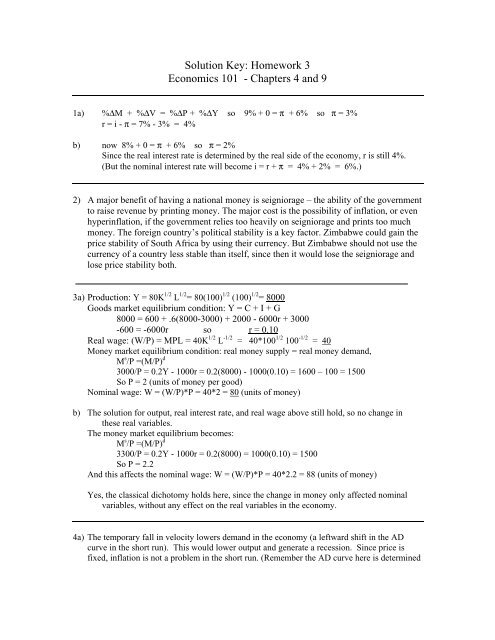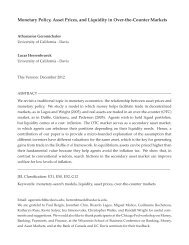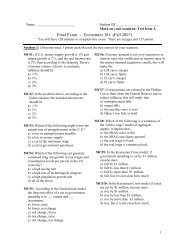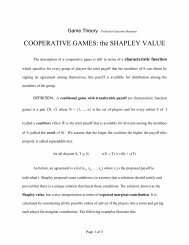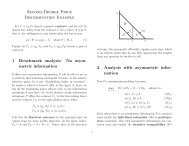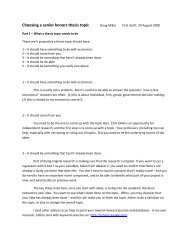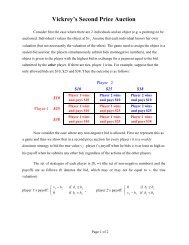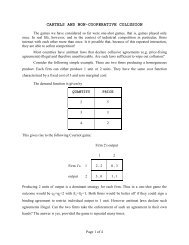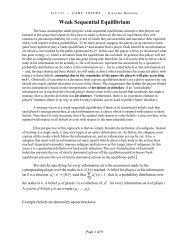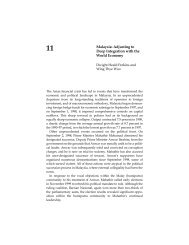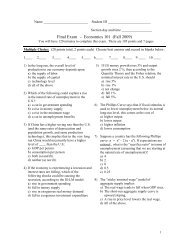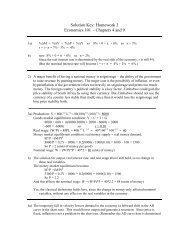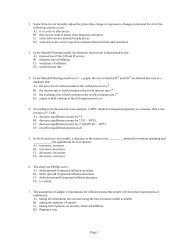Solution Key: Homework 3 Economics 101 - Chapters 4 and 9
Solution Key: Homework 3 Economics 101 - Chapters 4 and 9
Solution Key: Homework 3 Economics 101 - Chapters 4 and 9
Create successful ePaper yourself
Turn your PDF publications into a flip-book with our unique Google optimized e-Paper software.
<strong>Solution</strong> <strong>Key</strong>: <strong>Homework</strong> 3<br />
<strong>Economics</strong> <strong>101</strong> - <strong>Chapters</strong> 4 <strong>and</strong> 9<br />
1a) %ΔM + %ΔV = %ΔP + %ΔY so 9% + 0 = π + 6% so π = 3%<br />
r = i - π = 7% - 3% = 4%<br />
b) now 8% + 0 = π + 6% so π = 2%<br />
Since the real interest rate is determined by the real side of the economy, r is still 4%.<br />
(But the nominal interest rate will become i = r + π = 4% + 2% = 6%.)<br />
2) A major benefit of having a national money is seigniorage – the ability of the government<br />
to raise revenue by printing money. The major cost is the possibility of inflation, or even<br />
hyperinflation, if the government relies too heavily on seigniorage <strong>and</strong> prints too much<br />
money. The foreign country’s political stability is a key factor. Zimbabwe could gain the<br />
price stability of South Africa by using their currency. But Zimbabwe should not use the<br />
currency of a country less stable than itself, since then it would lose the seigniorage <strong>and</strong><br />
lose price stability both.<br />
3a) Production: Y = 80K 1/2 L 1/2 = 80(100) 1/2 (100) 1/2 = 8000<br />
Goods market equilibrium condition: Y = C + I + G<br />
8000 = 600 + .6(8000-3000) + 2000 - 6000r + 3000<br />
-600 = -6000r so r = 0.10<br />
Real wage: (W/P) = MPL = 40K 1/2 L -1/2 = 40*100 1/2 100 -1/2 = 40<br />
Money market equilibrium condition: real money supply = real money dem<strong>and</strong>,<br />
M s /P =(M/P) d<br />
3000/P = 0.2Y - 1000r = 0.2(8000) - 1000(0.10) = 1600 – 100 = 1500<br />
So P = 2 (units of money per good)<br />
Nominal wage: W = (W/P)*P = 40*2 = 80 (units of money)<br />
b) The solution for output, real interest rate, <strong>and</strong> real wage above still hold, so no change in<br />
these real variables.<br />
The money market equilibrium becomes:<br />
M s /P =(M/P) d<br />
3300/P = 0.2Y - 1000r = 0.2(8000) = 1000(0.10) = 1500<br />
So P = 2.2<br />
And this affects the nominal wage: W = (W/P)*P = 40*2.2 = 88 (units of money)<br />
Yes, the classical dichotomy holds here, since the change in money only affected nominal<br />
variables, without any effect on the real variables in the economy.<br />
4a) The temporary fall in velocity lowers dem<strong>and</strong> in the economy (a leftward shift in the AD<br />
curve in the short run). This would lower output <strong>and</strong> generate a recession. Since price is<br />
fixed, inflation is not a problem in the short run. (Remember the AD curve here is determined
y the equation M V = P Y. A fall in velocity would lower output for a given price level <strong>and</strong><br />
money supply.)<br />
P LRAS<br />
P1<br />
2 1,3<br />
SRAS<br />
AD1<br />
AD2<br />
Y<br />
Y2 Ybar<br />
Since the shock to velocity is only temporary, dem<strong>and</strong> will return to normal on its own in the<br />
long run. (AD shifts right in the long run back to its initial position. So there is no effect on<br />
output <strong>and</strong> no inflation in the long run.)<br />
b) To counteract the short-run effects of the shock, the Federal Reserve should increase the<br />
money supply in the short run. This would shift the AD to the right, returning it to its initial<br />
position. But it should reverse this policy in the long run. Otherwise when the velocity<br />
returns to normal in the long run, the extra money supply would generate inflation. (The AD<br />
curve would be to the right of its initial position before the velocity shock.)<br />
(10/28/09)


